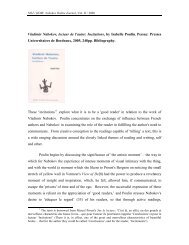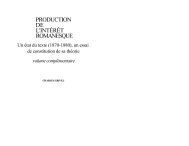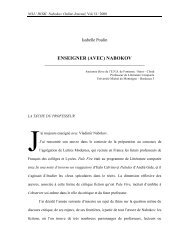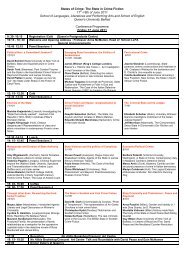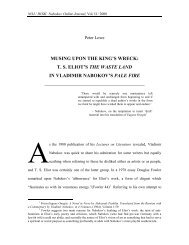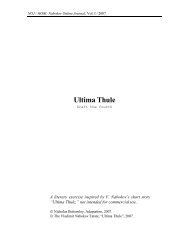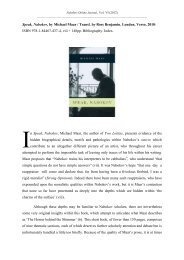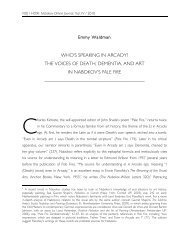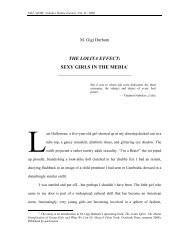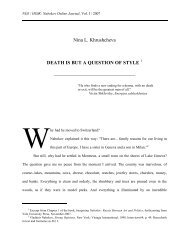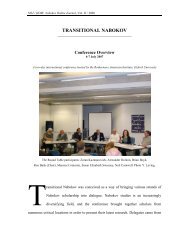domesticated translation: the case of nabokov's translation of alice's
domesticated translation: the case of nabokov's translation of alice's
domesticated translation: the case of nabokov's translation of alice's
You also want an ePaper? Increase the reach of your titles
YUMPU automatically turns print PDFs into web optimized ePapers that Google loves.
NOJ / НОЖ: Nabokov Online Journal, Vol. II / 2008<br />
stereotypical Irish name. “Pat” also encompasses many stereotypical features <strong>of</strong> <strong>the</strong> Irish<br />
dialect (“sure” at <strong>the</strong> beginning <strong>of</strong> a statement, “yer” for “your,” <strong>the</strong> pronunciation<br />
“arrum” for “arm,” etc.) (2003: 311). This ethnic and class identification is lost in<br />
Nabokov’s <strong>translation</strong>.<br />
Elsie, Lacie, and Tillie in <strong>the</strong> Dormouse’s story were renamed Masia, Pasia and<br />
Dasia (derivatives <strong>of</strong> <strong>the</strong> Russian names Masha, Pasha and Dasha) which, according to<br />
Connolly, allowed Nabokov to transfer <strong>the</strong> effect <strong>of</strong> sound repetition (1995: 19). The<br />
word “dormouse” was not a <strong>translation</strong> challenge because it has an equivalent in Russian<br />
which Nabokov used. The Russian word “sonia” has two uses: it can mean a dormouse<br />
and a person who likes to sleep, but it can also be a woman’s name. Considering both<br />
uses <strong>of</strong> this word, Nabokov was able to transfer <strong>the</strong> important characteristic <strong>of</strong> <strong>the</strong><br />
mouse’s sleepiness as well as add female connotations to her image. 8<br />
The absence <strong>of</strong> associative fields created a difficulty for Nabokov as well as for<br />
o<strong>the</strong>r translators <strong>of</strong> Alice into <strong>the</strong> Russian language. Carroll’s original is sated with<br />
allusions, hints, “speaking” names which, once translated into a different language, lose<br />
<strong>the</strong>ir hidden meaning. In <strong>the</strong> original, <strong>the</strong>re appears a “strange company” <strong>of</strong> a Duck, a<br />
Dodo, a Lori and an Eaglet. To follow <strong>the</strong> original allusion is quite difficult. However,<br />
“Duck” is supposed to refer to Reverend Duckworth, Carroll’s colleague and friend;<br />
“Lori” might stand for Lorina Liddell, Carroll’s eldest sister; “Eaglet” probably comes<br />
from Edith, Carroll’s youngest sister, and “Dodo” might refer to Lewis Carroll himself.<br />
In fact, all <strong>of</strong> <strong>the</strong> characters are supposed to have <strong>the</strong> ciphered names <strong>of</strong> <strong>the</strong> participants<br />
<strong>of</strong> <strong>the</strong> famous picnic on 4 July 1862, when Carroll told his story about a little girl named<br />
Alice for <strong>the</strong> first time (Demurova 1970:15-16).<br />
8 In <strong>the</strong> later <strong>translation</strong>s, <strong>the</strong> Dormouse has always been addressed as “she”.



